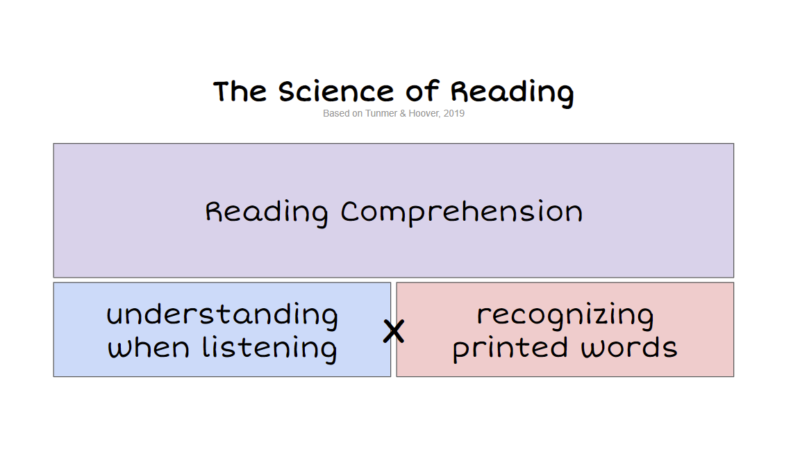Family Games and the Science of Reading
Written by Sandie Barrie Blackley, Speech-Language Pathologist
Published on June 30, 2011
We have been hearing more and more about the science of reading and the “fight over how to teach reading”. (See the New York Times article, “In the Fight Over How to Teach Reading, This Guru Makes a Major Retreat”.)
The science of reading tells us that reading comprehension is the product of understanding when listening and recognizing printed words.

While, as a parent, you may not think of yourself as a reading teacher, you may be curious about how family games and activities can support the two main components of reading comprehension: understanding when listening and recognizing printed words.
In this article, we’ll list some family games that support the two main components that the science of reading has found to be foundations for reading comprehension.
Listening Games |
Word Reading Games |
Simon SaysThis is a classic listening game for young children. One player is chosen to be “Simon”. Simon gives directions to the players by either saying “Simon says, Do ____”, or just, “Do ____”. If Simon began by saying “Simon says…” then the players are supposed to do as requested. But, if the command didn’t begin with “Simon says”, the players are to ignore the request. If Simon catches a player performing an action that was made without “Simon says” that player is out. |
ConcentrationThis is a highly adjustable matching game. To prepare for this game you will need to make a set of cards with 5 to 10 matching pairs, adjusted to the child’s current skill level. For example, for a beginning reader the pairs might be:
If the child is a more advanced reader the pairs might be homophones, like:
Or they could be words with the same base, like:
Using 3×5 inch index cards make 5 to 10 pairs of words. Shuffle the cards and place them face down in straight rows. Take turns turning up two cards at a time and reading the words aloud. If the two cards match, the player keeps them and gets a second turn. If they do not match, the cards are turned back over and the next player takes a turn. Play continues until all the cards are matched. The player with the most pairs wins. |
20 QuestionsThis is an easy, entertaining game that adapts to players of every age and language skill. Player A thinks of an object and gives a single clue: animal, vegetable, or mineral. Players B, C, D, etc., take turns asking questions about the object, trying to guess what it is. After each question, Player A answers yes or no, but can’t give any more clues. If the group can’t guess after asking 20 questions, Player A names the object and gets another turn. If someone guesses correctly, that person is next up to name an object. |
Scrabble SlamThis is a fast-paced word game played with cards. Player A gets to choose a four-letter word. Using the letter-cards in the deck, the word is spelled out face-up on the table. The remaining cards are shuffled and then the deck is dealt to the players. When play starts – “Go!” – everyone plays at once. The players choose one letter from their hand that will change the original word into a new word, for example, using a -k- to change WORD to WORK. The winner is the first person to use up all their cards. Then Player B chooses a word. |
Apples to ApplesThis popular card game works best for four or more players, though it can be played with three in a pinch. Red Apple cards are dealt to each player. Player A, the judge, chooses a Green Apple card and places it face up. The other players then choose the Red card in their hand that comes closest to describing the judge’s Green card. The judge selects the best match, the winner collects a point and then Player B gets to be judged. Note: Apples to Apples Junior is targeted to ages 9 and up. |
BananagramsThis is a timed tile game in which each player uses his or her own tiles to create a linked (Scrabble-style) grid of words. It can be played by two to seven players, ages 7 (or so) and up. You can adjust this game by eliminating the timing component, working in teams instead of individually, and/or using only words from a single category, such as animals, colors, numbers, etc. The clever game-smiths at Bananagrams have now added a number of other terrific word/language tile games (Appletters, PAIRSinPEARS, ZIP-IT and Fruitominoes) to their collection. |
CategoriesAnother terrific all-ages game that requires no equipment and works for large groups as well as small. This game works particularly well if everyone’s sitting in a circle. Player A names a category, for example, candies, colors, and flowers. Then, starting with Player B and moving around the circle as quickly as possible, each player names something that fits into that category (a type of candy, a color, the name of a flower). When you get back to Player A, then Player B gets to name a category. This game has no single winner, but can generate a lot of laughs and stimulate vocabulary. |
CategoriesThis game can be adapted to focus on categories related to printed words. For example, name words that:
|
Do you have a favorite family game? For more reading ideas, click here.
Happy playing!
Don’t forget to sign up for our blog so that you do not miss out on any of our resources. If you suspect your child has dyslexia or other learning disability, take one of our free tests here. You can also contact us at 1-919-747-4557 or email info@lexercise.com.
Improve Your Child’s Reading
Learn more about Lexercise today.
Schedule a FREE
15-minute consultation


